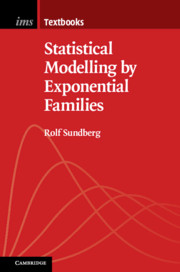Refine search
Actions for selected content:
2348 results in Statistical theory and methods

Statistical Modelling by Exponential Families
-
- Published online:
- 17 July 2019
- Print publication:
- 29 August 2019
10 - Network Data
-
- Book:
- Model-Based Clustering and Classification for Data Science
- Published online:
- 14 June 2019
- Print publication:
- 11 July 2019, pp 292-330
-
- Chapter
- Export citation
1 - Introduction
-
- Book:
- Model-Based Clustering and Classification for Data Science
- Published online:
- 14 June 2019
- Print publication:
- 11 July 2019, pp 1-14
-
- Chapter
-
- You have access
- Export citation
11 - Model-based Clustering with Covariates
-
- Book:
- Model-Based Clustering and Classification for Data Science
- Published online:
- 14 June 2019
- Print publication:
- 11 July 2019, pp 331-350
-
- Chapter
- Export citation
9 - Non-Gaussian Model-based Clustering
-
- Book:
- Model-Based Clustering and Classification for Data Science
- Published online:
- 14 June 2019
- Print publication:
- 11 July 2019, pp 259-291
-
- Chapter
- Export citation
Contents
-
- Book:
- Model-Based Clustering and Classification for Data Science
- Published online:
- 14 June 2019
- Print publication:
- 11 July 2019, pp x-xiv
-
- Chapter
- Export citation
2 - Model-based Clustering: Basic Ideas
-
- Book:
- Model-Based Clustering and Classification for Data Science
- Published online:
- 14 June 2019
- Print publication:
- 11 July 2019, pp 15-78
-
- Chapter
- Export citation
Bibliography
-
- Book:
- Model-Based Clustering and Classification for Data Science
- Published online:
- 14 June 2019
- Print publication:
- 11 July 2019, pp 386-414
-
- Chapter
- Export citation
List of R Packages
-
- Book:
- Model-Based Clustering and Classification for Data Science
- Published online:
- 14 June 2019
- Print publication:
- 11 July 2019, pp 384-385
-
- Chapter
- Export citation
8 - High-dimensional Data
-
- Book:
- Model-Based Clustering and Classification for Data Science
- Published online:
- 14 June 2019
- Print publication:
- 11 July 2019, pp 217-258
-
- Chapter
- Export citation
Frontmatter
-
- Book:
- Model-Based Clustering and Classification for Data Science
- Published online:
- 14 June 2019
- Print publication:
- 11 July 2019, pp i-iv
-
- Chapter
- Export citation
12 - Other Topics
-
- Book:
- Model-Based Clustering and Classification for Data Science
- Published online:
- 14 June 2019
- Print publication:
- 11 July 2019, pp 351-383
-
- Chapter
- Export citation
6 - Discrete Data Clustering
-
- Book:
- Model-Based Clustering and Classification for Data Science
- Published online:
- 14 June 2019
- Print publication:
- 11 July 2019, pp 163-198
-
- Chapter
- Export citation
Contents
-
- Book:
- Model-Based Clustering and Classification for Data Science
- Published online:
- 14 June 2019
- Print publication:
- 11 July 2019, pp vii-ix
-
- Chapter
- Export citation
Subject Index
-
- Book:
- Model-Based Clustering and Classification for Data Science
- Published online:
- 14 June 2019
- Print publication:
- 11 July 2019, pp 423-427
-
- Chapter
- Export citation
7 - Variable Selection
-
- Book:
- Model-Based Clustering and Classification for Data Science
- Published online:
- 14 June 2019
- Print publication:
- 11 July 2019, pp 199-216
-
- Chapter
- Export citation
Dedication
-
- Book:
- Model-Based Clustering and Classification for Data Science
- Published online:
- 14 June 2019
- Print publication:
- 11 July 2019, pp v-vi
-
- Chapter
- Export citation
Author Index
-
- Book:
- Model-Based Clustering and Classification for Data Science
- Published online:
- 14 June 2019
- Print publication:
- 11 July 2019, pp 415-422
-
- Chapter
- Export citation
5 - Semi-supervised Clustering and Classification
-
- Book:
- Model-Based Clustering and Classification for Data Science
- Published online:
- 14 June 2019
- Print publication:
- 11 July 2019, pp 134-162
-
- Chapter
- Export citation
Preface
-
- Book:
- Model-Based Clustering and Classification for Data Science
- Published online:
- 14 June 2019
- Print publication:
- 11 July 2019, pp xv-xviii
-
- Chapter
- Export citation
